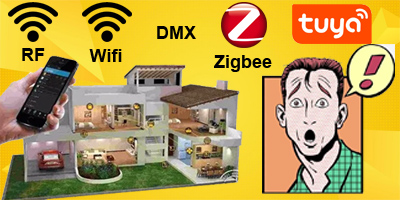
There are a multitude of dimmers, controllers and devices of all kinds to control your strips, spotlights and led lamps.
But which one will work with my lighting? this is the subject of this tutorial which will most likely enlighten you on the choice of the appropriate equipment to acquire.
If that's not enough, don't hesitate to ask us for advice via the Contact form, or directly via the live chat available to you, at the bottom right of your screen.
Here are the topics covered in this tutorial:
Direct connection of a led strip, spotlights and led lamps.
This is the simplest solution for setting up your lighting device.
If you use a white led strip or a single color, one or more spotlights or led lamps, the connection is very simple and does not require a controller , nor dimmer.
Only the main switch in your room will be enough to turn the lighting on or off.
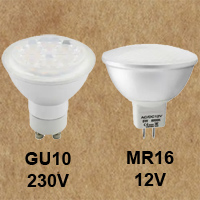
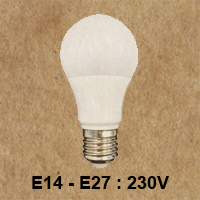
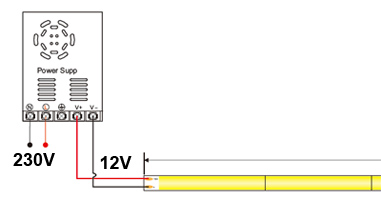
Check the supply voltage carefully:
- E14, E27 bulbs in 220V
- GU10 spotlights in 220V
- MR16 spotlights in 12V
- Other spotlights: check the supply voltage given in the technical characteristics of the product before connecting.
- Led projectors: They can be 12, 24 or 220V. Check the supply voltage given in the technical characteristics of the product before connecting.
- 12 or 24V led strip depending on the model (See the technical characteristics before connection)
If, in addition to turning on or off, you want to vary the light intensity, you will need to add a dimmer to make your lighting more comfortable.
Light intensity dimmers.
220V lamps and spotlights
If you are using 220V lamps, you will need a wall dimmer that varies the voltage applied to the bulb.
The voltage variation is done on the 230V circuit.
This device reduces the voltage to lower the light intensity.
Check that the lamp or spot is dimmable before buying. Otherwise, as soon as you try to reduce the intensity, the lamp will go out directly or start flashing, without any variation.
Led strip, lamps and spotlights 12 or 24V
For low voltage luminaires, there are 2 types of dimmers.
The first solution is to use a wall dimmer on the 230V circuit.

In this case, you have the dimmer, as well as a triac power supply which will vary the voltage applied to the led light on 12 or 24V.
Check here again that the lamp, spot or led strip is dimmable before purchasing. Otherwise, as soon as you try to reduce the intensity, the LEDs will go out directly or start flashing, without any variation.
The decrease in light acts proportionally on power consumption. For example, vi under reduce the light by 50%, the energy consumed will be only 50% of the power indicated on the product.
The second solution consists in using a dimmer whose light variation is done by modulating the input signal (PWM or GFSK) by turning the LEDs on and off very quickly.

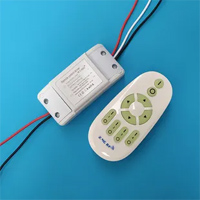
Dimming by modulation offers the advantage of being cheaper than the triac device, while giving a completely satisfactory result for domestic use.
In addition, this type of dimmer often offers many home automation features: control by applications, grouping into zones, voice control (Google and Alexa), control by remote control, Wifi and Zigbee.
On the other hand, this process has the disadvantage of causing a slight flickering effect when taking a video of the lit room, which results in horizontal lines in the image.
The lower the light, the more visible this effect will be on the camera.
Variable white, RGB, RGBW, RGB+CCT controllers
Controllers are essential to use a led strip, a bulb, a spotlight or a led light panel using several shades of white or colors.
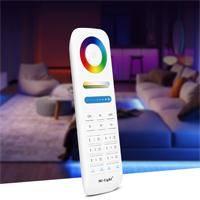
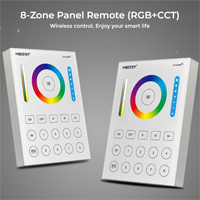
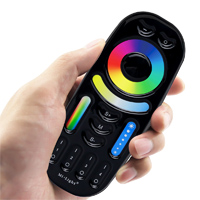
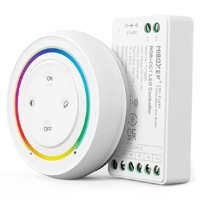
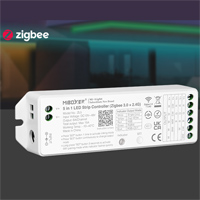
They are used for:
- variable white led strips (CCT) to switch on, switch off, change the shade of white between warm white and cold white, through a large number of intermediate whites, and of course vary the light intensity.
- multicolored LED strips (RGB) to turn on, turn off, change the color (including white), and vary the light intensity.
- multicolor + white led strips (RGBW) to turn on, turn off, change the color and intensity of colors and white.
- multicolored led strips + variable white (RGB+CCT) to turn on, turn off, change the color, the shade of white and the light intensity.
They use 12 or 24V signal modulation (PWM or GFSK) and allow fingertip and eye control of your lighting device, throughout the house.
A controller can be controlled:
- by remote control (RF 2.4 GHz), on one or more zones, separate or grouped. Note that several receivers (controllers) can be associated with a single remote control
- in Wifi with your smartphone or tablet thanks to applications offering many functions such as animation to the rhythm of music, timer, automatic ignition on time slots...
- In Zigbee, here again with your phone, with extended range, reduced energy consumption and without saturating your Wifi network
- by voice using Google and Alexa voice assistants
Most controllers can simultaneously manage a remote control, WiFi control and voice assistants.
Consult the product sheets to ensure multiple compatibilities or ask us for advice before ordering a controller.
Zigbee controllers
This is our favorite type of controller because it provides optimal efficiency for your led lighting home automation.

Zigbee is a wireless communication protocol that was developed for home automation and Internet of Things (IoT) applications.
It is often compared to Wi-Fi because they are both used for wireless connectivity in homes and buildings.
However, there are key advantages of Zigbee over Wi-Fi that make it more suitable for certain types of IoT applications.
First of all, Zigbee has a longer range than Wi-Fi, thanks to its technology using the mesh network, without hierarchy. This makes it more suitable for applications that require connectivity, such as sensors, thermostats and light switches, and of course led controllers.
Secondly, Zigbee is more energy efficient than Wi-Fi. It uses a narrower bandwidth and lower transmit power, which means it consumes less power.
This makes it more suitable for applications that require long battery life, such as motion sensors and smoke detectors. Wi-Fi, on the other hand, consumes more power, which can make battery-powered devices less reliable.
The Zigbee protocol, currently in version 3.0, is more stable than WiFi, which is a significant asset for a reliable network.
Finally, Zigbee is more secure than Wi-Fi. It uses military-grade cryptography to protect transmitted data, making it less vulnerable to hacker attacks.
Wi-Fi, on the other hand, is more vulnerable to hacking attacks because it uses less robust security protocols.
For our network of led lighting devices in several rooms of the house, the use of a Zigbee gateway greatly reduces the congestion of the Wifi network which results in stalls and untimely disconnections of the controllers.
What could be more annoying than not being able to turn the light on or off when using your phone, or gently asking Alexa to turn on the living room and getting this response: Sorry, l living room device not responding.
Fortunately, the Zigbee solution is there to prevent this kind of incident from happening again.
Note that the use of a Zigbee gateway is essential to use this type of controller.
A single gateway can manage 50 or 128 devices depending on the model chosen.
DMX controllers
DMX controllers connect directly to your console, or possibly to a USB DMX adapter, to control all your LED strips and LED projectors very precisely.
You can organize your sequences (animations) as you see fit to manage all of your lighting.
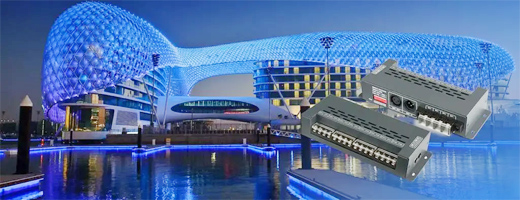
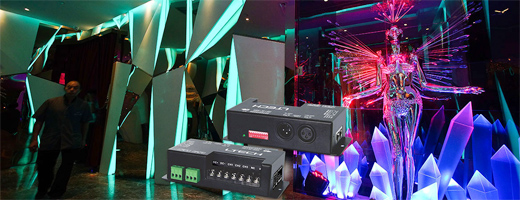
A controller can generally manage 512 channels. For more complex use, DMX universes should be used to control a very large number of light sources.
Here is how the DMX channels are used depending on the types of led lighting:
- LED strips or white or single-colour projectors: only 1 channel is used. The value sent to the device adjusts the brightness from 0 (off) to 255 (full power).
- LED strips or variable white projectors: 2 DMX channels are used. One for cold white and the other for warm white. Each one will have a value from 0 to 255. The mixture makes it possible to obtain different shades of white and luminosity (65536 variants).
- LED strips or RGB projectors: 3 DMX channels are used. One for red, one for green and one for blue. Each will have a value from 0 to 255. The mixture allows to obtain different colors and luminosity (16 million variants).
- LED strips or RGBW projectors: 4 DMX channels are used. One for red, one for green, one for blue and the last one for white. Each will have a value from 0 to 255. The mixture allows to obtain colors, white and different luminosity (4.2 billion variants).
- LED strips or RGB+CCT projectors: 5 DMX channels are used. One for red, one for green, one for blue, one for cold white and the last one for warm white. Each will have a value from 0 to 255. The mixture allows to obtain colors, shades of white and different luminosity (1099 billion variants).
For the ribbons above, piloting will be done over the entire length of the headband.
The power of DMX is particularly useful for LED strips with dynamic effects (Magic), making possible animations such as cheillards, water drop effects, colored crosses, flashes, fades, rainbow effects... < br /> The only limit will be your imagination.
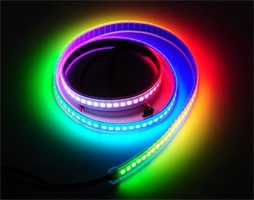
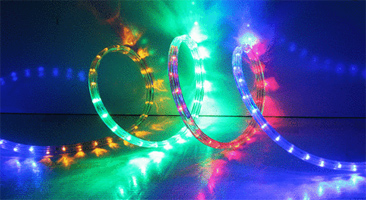
If the rendering of such a ribbon is spectacular, it is no less greedy in DMX channels:
- Dynamic RGB led strips 3 leds per pixel 30 leds/m: 30 DMX channels per meter are used. First channel for the first 3 red LEDs, second channel for the first 3 green LEDs, third channel for the first 3 blue LEDs. Fourth channel for 3 red leds 4, 5 and 6, fifth channel for the 3 green leds 4, 5 and 6, sixth channel for the 3 blue leds 4, 5 and 6 etc...
- RGB dynamic led strips 3 leds per pixel 60 leds/m: 60 DMX channels per meter are used. Same addressing as above
- RGB dynamic led strips 1 led per pixel 30 leds/m: 90 DMX channels per meter are used. Same addressing, but this time led by led
- RGB dynamic led strips 1 led per pixel 60 leds/m: 180 DMX channels per meter are used
- RGB dynamic led strips 1 led per pixel 144 leds/m: 432 DMX channels per meter
- RGB+CCT dynamic led strips 3 leds per pixel 30 leds/m: 50 DMX channels per meter
- RGB+CCT dynamic led strips 3 leds per pixel 60 leds/m: 100 DMX channels per meter
- RGB+CCT dynamic led strips 1 led per pixel 30 leds/m: 150 DMX channels per meter
- RGB+CCT dynamic led strips 1 led per pixel 60 leds/m: 300 DMX channels per meter
DMX control is most of the time used by professionals (concert halls, theaters or discotheques).
It is advisable to use a quality and durable material. This is why we offer on Wedooled the Ltech brand for intensive use and reactive signal transmission.
Beware of the length of the cable between the controller and the start of the led strip, which should not exceed 7 meters.
Beyond that, there may be a loss of SPI signal and cause erratic operation of the led strip.
It is then possible to use SPI signal amplifiers to overcome this problem.
DMX adapters
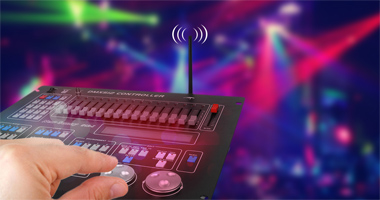
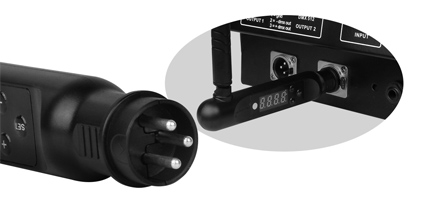
If you have a DMX console, you can use an adapter that plugs directly into the console using its built-in XLR-3 socket.
The DMX signal is converted into 2.4 GHz radio frequency to control a bulb, a spotlight or a controller connected to one or more LED strips.
Make sure that your bulb or controller communicates in 2.4 GHz, which is the case for the majority of the Mi-ight / Miboxer range.
The adapter can control up to 16 RGB + variable white light sources (RGBCCT), i.e. 16 x 5 channels (80 DMX channels in total).
This solution is a good alternative for a small installation, but not suitable for large professional use.
